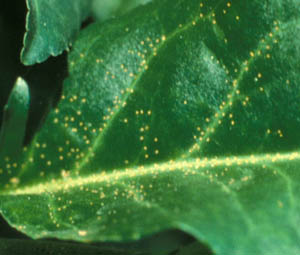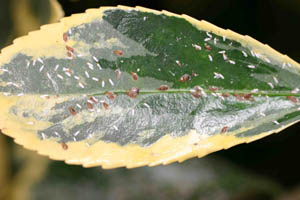Euonymus Scale | |
|---|---|
| May 16, 2006 | |
With beautybush (Kolkwitzia amabilis) blooming throughout portions of Illinois, it is time to be cognizant of euonymus scale (Unaspis euonymi) crawlers moving around on plant parts looking for a place to settle down and initiate the feeding process. The primary hosts in Illinois are evergreen euonymus (Euonymus japonica) and Japanese pachysandra (Pachysandra terminalis). Euonymus scale crawlers resemble small yellow spots that move around on stems and leaves. Plants that are experiencing “stress” are more susceptible to attack than plants that are receiving sufficient quantities of water and fertilizer. Why is this so? The main reason is that plants can naturally defend themselves when supplied with the appropriate amount of water and nutrients. Euonymus scale crawlers resemble small yellow spots that move around on stems and leaves. Plants that are experiencing “stress” are more susceptible to attack than plants that are receiving sufficient quantities of water and fertilizer. Why is this so? The main reason is that plants can naturally defend themselves when supplied with the appropriate amount of water and nutrients.  Euonymus scale overwinters as a mated female, primarily on plant stems. Eggs develop and mature underneath the scale, and then hatch over a 2- to 3-week period. The newly hatched crawlers migrate along the stem and initiate feeding near the base of host plants. Crawlers can also infect adjacent plants by being blown around on air currents, which results in infestations often not being detected until populations are high and damage is noticeable. Leaves eventually are spotted with yellow or white areas. Plants located near structures, such as along foundations or walls, tend to be more susceptible than plants growing in open areas that receive sufficient air movement. Additionally, the variegated forms of euonymus are more susceptible than the green forms. Heavy infestations of euonymus scale can ruin the aesthetic appearance of plants, causing complete defoliation or even plant death. Females are dark brown, flattened, and shaped similar to an oystershell. Males, however, are elongated, ridged, and white in color. Males tend to be located on leaves, whereas the females reside on stems and along leaf veins. In Illinois, there are two generations per year. Cultural practices, such as pruning out heavily infested branches—without ruining the aesthetic quality of the plant—are an extremely effective means of quickly reducing scale populations. Be sure to discard pruned branches away from the area as soon as possible. If feasible, avoid planting Euonymus japonica in landscapes, as this species is highly susceptible to euonymus scale. Winged euonymus (Euonymus alata) is less susceptible to euonymus scale, even when adjacent plants are infested. Insecticide applications performed in late May through early June, which is when the crawlers are most active, helps minimize major problems with euonymus scale later in the season. Insecticides recommended for control of euonymus scale, primarily the crawlers, include acephate (Orthene), bifenthrin (Talstar), cyfluthrin (Tempo), insecticidal soap, and horticultural or summer oil. It is important to check plants regularly for the presence of crawlers, which will help in timing insecticide applications. Three to four applications made at 7- to 10-day intervals may be needed, depending on the infestation. Remember that euonymus scale is a hard or armored scale, so soil or drench applications of imidacloprid (Merit) are not effective. Euonymus scale is extremely susceptible to a variety of natural enemies, including parasitoids and predators. These include braconid and ichneumonid wasps, ladybird beetles, green lacewings, and minute pirate bugs. However, in some instances, natural enemies may fail to provide enough mortality to significantly impact high populations of euonymus scale. Additionally, insecticides such as acephate (Orthene), bifenthrin (Talstar), and cyfluthrin (Tempo) are extremely harmful to natural enemies, so applications of these materials disrupt any natural control.< |